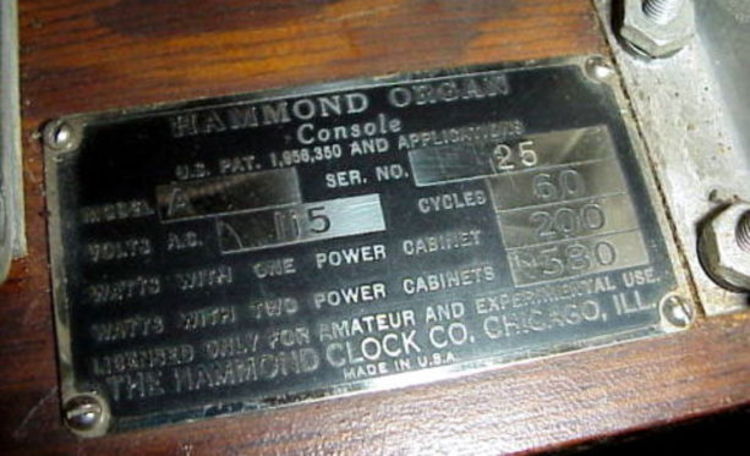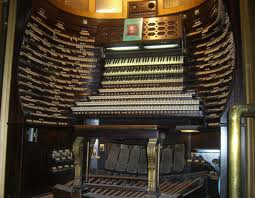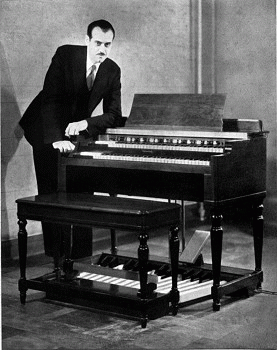Laurens Hammond
- Laurens Hammond Story
- Het Patent
- Het privéleven van Laurens Hammond
- Overzicht Uitvindingen
- Hammond 25 years (Eng)
- Hammond 50 years (Eng)
- Fabrieken, relaties en privé-bezittingen (Eng)
- Hammond, de uitvinder
- De Reddende Wrigley Deal
- Kort overzicht Hammond factory (Eng)
- Hammond versus pijporgel 2004
- De Hammond Archieven 1
- De Hammond Archieven 2
- De Hammond rechtzaak (Eng)
De Hammond rechtzaak
Courtcase below in English. Introduction in Dutch language
Laurens Hammond had een orgel uitgevonden met toonwielen en drawbars als eventuele vervanger voor een kerkorgel. Omdat je met die drawbars - zoals we weten - een gigantisch aantal geluiden kon samenstellen, noemde Laurens zijn uitvinding: een "Orgel met een oneindig aantal verschillende geluiden".
Er is niets nieuws onder de zon, want ook toen al was er afgunst en kritiek en dit keer vanuit de behoudende klassieke hoek. De POMA, de Pipe Organ Manufacturers Association, verklaarde Hammond de oorlog, want die (pijp)organisten en (pijp)orgelfabrikanten zagen hun hele handel al instorten. Dit was aanleiding tot één van de meest beroemde rechtszaken in de muziek industrie.
De jury kwam tot een oordeel dat Laurens Hammond nooit meer zeggen en adverteren mocht in de zin van: "Een oneindig aantal geluiden"
Hij mocht alleen nog spreken en adverteren met 253.000.000 (253 miljoen) geluiden.
Dat was uiteraard wel een beperking in klankkleuren....
Kinderachtig, maar echt weer Amerikaans was, zoals hier direct boven te zien is, het orgel alleen gelicenceerd voor "amateur en experimenteel gebruik", omdat Laurens Hammond allerlei rechtzaken moest voeren, flink dwarsgezeten door de pijporgel-fabrikanten, en daarom werd hij door de FTC (Federal Trade Commission) in 1936 gedwongen dit op zijn serieplaatjes te vermelden om toestemming te krijgen zijn instrumenten te verkopen, zolang de hele zaak niet was opgelost.
Lees hieronder het volledige en zeer boeiende verslag van één van de bijzondere juridische gedingen:
1937 Complaint filed by The Federal Trade Commission by the Pipe Organ Manufacturers Association (https://apoba.com) as compiled by Charles Richard Lester.
Complaint against the Hammond Organ Company
The file read:
On January19, 1934 inventor Laurens Hammond filed an application for a patent for the new Hammond Electric Organ after demonstrating the instrument in the basement of the Patent Office. With unprecedented speed, the patent was granted on April 24, in the hope that it would create employment in an economy heavily dependent upon WPA.
Owing to its low cost, extremely compact size, ease of installation (just "cart it in and connect it to the electric current") through word-of-mouth publicity and heavy advertising in organ trade publications as well as numerous home-consumer magazines such as Saturday Evening Post, Good Housekeeping, Life, Look, etc. sales of the Hammond Organ took off with great vigor. The Hammond Organ soon began to appear across the country in living rooms as well as in the auditoriums of religious organizations.
—oOo—
In August 1935, the Hammond Company ran ads in organ journals with claims of having placed the instruments in 567 churches. Profits of $228,393 in 1936 and $364,680 in 1937 were reported.
Pipe organ builders fought ads with ads. 1936 organ-related journals carried promotions for the "genuine article," countering Hammond‘s paid announcements of the number of churches in which the Hammond product had been installed.
Meanwhile the American Guild of Organists took up the matter of the electronic instrument. While the use of the word "organ" was questioned, the A.G.O. Council found more important the claim that these instruments could produce the effects possible on a pipe organ.
https://www.agohq.org/
Complaints were filed with the Federal Trade Commission in 1935, charging the Hammond Clock Co. with unfair competition.
After questioning the very right to call Hammond "an organ" the complaint alleged that "said instrument is not capable of producing the entire range of musical tone colors nor a range in harmonics equivalent to the range in harmonics of a pipe organ"
Newspapers headlined the action: "Must an Organ Have Windpipes?
U. S. to Decide." Robert J. Casey of the Chicago Daily News wrote quizzically: "Experts have admitted that the silent Hammond in the hearing room can be just as silent as a $250,000 pipe organ and in smaller space."
No action was taken at that time, but the case was reopened in 1937, when a Federal Trade Commission complaint was issued on Feb. 2, 1937 by the now-defunct Pipe Organ Manufacturers Association. A long-standing but unsubstantiated rumor suggests that the entire suit was initiated and financed by the owner of a well-known Midwestern pipe organ company.
The charges alleged that Hammond‘s claim that its product could replicate a $10,000 pipe organ was fraudulent. Plaintiffs argued that the instrument didn‘t come even close to the sound of a pipe organ and could not legally even be called an "organ." The complaint further charged the Hammond Company with misrepresentation of the tone quality and value of the Hammond instrument.
The statement of the Federal Trade Commission explained:
"Among representations allegedly made by the respondent company in its advertising matter are that use of ‘The Hammond Organ’ means ‘that real organ music of unbelievably beautiful quality is now possible in any home at an expense no greater than that of a good piano. That the instrument produces the entire range of tone coloring necessary for the rendition, without sacrifice, of the great works of classical organ literature and that many organists agree the instrument is comparable to pipe organs costing $10,000,- plus.
"The complaint was that these and similar representations were false, that with the exception of the flute notes the respondent‘s instrument is not capable of producing faithfully the musical tones of a pipe organ necessary for the accurate, adequate rendition of the great compositions of organ music. That it's tone is not an improvement over that of any modern organ of recognized merit and that it is not comparable to a $10,000 pipe organ or to any pipe organ."
Laurens Hammond, not frightened by the government or anyone else to be "weak" fought the charges vehemently, using every legal and monetary angle at his disposal.
Hearings began in Chicago in March 1937 and the debates make up one of the liveliest chapters in American organ history, as organists and builders sought to prove what an organ can and should do.
Dr. C.P. Boner, professor of physics at Texas University, used a tone analyzer to compare a Hammond instrument with the pipe organ in the home of Dr. William H. Barnes. Senator Emerson Richards, Arthur Dunham, William Lester, William H. Barnes, Horace Whitehouse and Barrett Spach were among the organ authorities who testified in the hearings.
At one point, Mr. Spach stated that Hammond "falsified the intentions of Bach." Lynn A. Williams, counsel for Hammond, asked, "Did Bach tell you what his intentions were?" to which Mr. Spach retorted, "Did Blackstone tell you what his intentions were?"
Laurens Hammond was, of course, examined. Part of his testimony consisted of demonstrations of the tonal resources of a Hammond instrument that had been set up in the courtroom.
Hammond testified that his instrument could do the things claimed for it and further, that it could do many things that a pipe organ could not do, and in this respect was a "noticeable improvement" on the organ. A member of the Hammond company "reproduced for the entertainment of the audience the rumblings of the San Francisco earthquake, a guitar solo, a xylophone, a dance orchestra, a calliope at the circus, a whistler and a dog, a locomotive whistle and other classics not found on service lists."
The 1937 hearings were reopened in Atlantic City and were then followed by the final hearing in Washington, D.C.
Dr. Charles Courboin and T. Scott Buhrman were new witnesses. There were additional demonstrations, this time using the Atlantic City Convention Hall Organ and a Hammond Organ that had been set up in a church.
Dr. Boner again testified in the final hearings. The December issue of The Diapason described his experiments since the Chicago hearings. They were made outdoors, "a trumpet pipe being placed in a tower twenty-three high and a microphone in another tower of the same height, while a Hammond electronic organ was raised to the top of a pole with block and tackle and the wave analyzer was again brought into use." Boner concluded that a Hammond instrument would have to have thirty to forty drawbars to duplicate organ tones and finally, that it could not produce pipe organ music.
Both Chicago papers carried news of the hearings, as did the national wires, with one reporter dubbing the whole affair a "tempest in a teapot"
To wrap up the hearings, a totally unscientific "A-B" comparison test was conducted. A Hammond Model A Organ with six power cabinets and twenty-four amplifiers (total value including tone cabinets, $2,640) was installed in the University of Chicago Chapel.
The Hammond tone cabinets were concealed amidst the pipes of the $75,000 Skinner pipe organ in the chapel and screens hid the consoles of both organs so that the audience could not see which was being played.
Organist Porter Heaps — who was even then an employee of Hammond Clock Co. and hired to promote the new Model A — played both the Hammond and the Skinner to a varied audience, including the judges, the parties, the press and interested public.
Heaps was a skillful organist and charges immediately flew that he deliberately used registrations on the Skinner that were ‘more favorable’ to the Hammond than not, meaning a preponderance of stopped flute voices, something the Hammond can -almost - get away with.
In addition to company officials, lawyers and U. S. employees, the audience included two juries. One was a group of 15 university students. The other was an assemblage of ten distinguished musicians, including six excellent pipe organists as well as renowned conductors Daniel Saidenberg and Ebba Sundstrom.
Both juries were given pencil and paper and asked to note whether the thirty odd compositions heard were played on the pipe or Hammond organ. The students were right on an average of fifty per cent. Obviously they couldn‘t tell the difference.
The musicians did both better and worse, with errors ranging from 10 to 90 per cent.
Early in 1938, the Hammond Company tried to induce the Federal Trade Commission to listen to a Hammond organ and judge for itself. Chairman Garland S. Ferguson declined. "The Federal Trade Commission is a judicial body and not a group of musical critics."
The final oral arguments took place in April 1938. Hammond‘s attorney predicted that pipe organ building would soon be as lively a business as the making of kerosene lamps.
On July 12 the Federal Trade Commission ordered the Hammond company to cease its claims that its instruments could equal a pipe organ in its range of harmonics, that it could produce the tone colors necessary for proper rendition of the great works of organ literature, or that it was comparable to a $10,000 pipe organ.
In comic-opera fashion, the FTC ruled against one of Hammond‘s claims:
The company could not continue to advertise that the organ could produce an infinite number of tones. It could only claim the mathematically calculated total of only 253 million possible tones. However, the Commission did describe the Hammond Organ as "an organ" and permitted the Hammond Company the legal use of the term.
After the trial Laurens Hammond said that the case had cost a considerable sum, but the publicity had been so extensive that resulting extra sales had covered the expense and therefore he claimed victory.
Thus, the ire of pipe organ manufacturers unwittingly publicized the new instrument and by the bitterest of ironies secured Hammond‘s right to describe its product as an organ.
However, Hammond‘s "victory" was a shallow one. Despite Hammond‘s being granted the right to call its instrument an "organ" in its advertising, experienced pipe organ builders - and organists who were trained on and played pipe organs - obviously knew the difference.
Pipe organ proponents quite rightly can show the Hammond‘s many weaknesses, not the least of which are due to a scarcity of harmonics. Furthermore, the dissonant "harmonics" of the drawbar system are completely out of tune and the temperament of the instrument is off of Equal Temperament by as much as 0.7 cents.
Add to this the single channel audio system fed by a solitary rank of tonewheeled alternators, keyed through a crude switching arrangement and you get the famous "Hammond sound", with all its warts and foibles, which Hammond fanciers dearly love. But which will never excell, let alone equal a "$10,000.- pipe organ."
Some members of the pipe organ industry claimed that the comparison was so ludicrous that the case was simply another example of corporate hijacking of the US political system. It has been asserted that the FTC judges were obviously bought off.
It is well known that the administrative law judges daily lunches were perfumed with the able musical talents of the great and very well-known theatre organist, Dr. C.A.J. "Cass" Parmentier. During the hearings, Laurens Hammond hired Parmentier to play a Hammond Organ. The instrument was installed free of charge in the restaurant where the judges hearing the case always had lunch. Cass was given strict instructions to try to make the Hammond Model A sound as much like a pipe organ as he could and was paid a reportedly handsome fee for doing so. Near the end of the hearings one of the judges leaned over to Cass, winked his eye and said "Sounds like an organ to me!"
—oOo—
A look back through history clearly shows how the Hammond Organ became a unique instrument in its own right. Ultimately, it was no longer looked to as a replacement for pipe organs, but instead, found its home first in jazz, then gospel and eventually rock and other popular music. Perhaps its most low-brow application was providing musical background for daytime radio dramas - the "soap operas.
These "new uses" for the Hammond Organ came about despite the wishes of Laurens Hammond who was ardently opposed to such "vulgarity"
His idea for the Hammond Organ was as originally marketed and advertised a vehicle for entertainment in the home and as a low-cost replacement for church pipe organs.
He fought with particularly impassioned valor against the intrusion into his world by Don Leslie and his magical speaker.
Hammondists can state with gratitude that Mr. Hammond lost this battle.
For a Hammond without a Leslie is LESS than half the instrument that it is WITH a Leslie. Even for "traditional" church music!
The ubiquitous combination of B3 + Leslie has since been elevated to cult status, to the point that some "Hammond Purists" are bemoaning the introduction in 2001 of the new "Retro-B3," by Hammond/Suzuki, a digitally sampled instrument which Hammond/Suzuki claims "faithfully reproduces the authentic tonewheel sound of the vintage Hammond B3."
The jury is still out on that claim. Will the world of music see another circus like show such as it saw in 1937 as the claim is hotly refuted by its detractors and ardently defended by its manufacturers?
Regardless of how that may eventually play out, the pipe organ world has reacted with great bemusement at the ironic turn of events that Hammond Tonewheel Purists are rejecting digital simulations of their beloved instrument.
By 1935 organists and organ builders alike had become concerned about Hammond‘s advertising and claims that its $1,250 instrument could serve a church as well as a pipe organ costing much more. The fact that these instruments were called "organs" was also a matter of concern to some, although that objection did not actually become the major issue.




